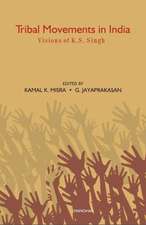Consumer Culture and Society
Autor Wendy Wiedenhoft Murphyen Limba Engleză Paperback – 16 oct 2016
Preț: 563.98 lei
Preț vechi: 619.75 lei
-9% Nou
Puncte Express: 846
Preț estimativ în valută:
107.91€ • 112.98$ • 89.29£
107.91€ • 112.98$ • 89.29£
Carte tipărită la comandă
Livrare economică 07-21 aprilie
Preluare comenzi: 021 569.72.76
Specificații
ISBN-13: 9781483358154
ISBN-10: 1483358151
Pagini: 272
Dimensiuni: 152 x 229 x 15 mm
Greutate: 0.39 kg
Ediția:1
Editura: SAGE Publications
Colecția Sage Publications, Inc
Locul publicării:Thousand Oaks, United States
ISBN-10: 1483358151
Pagini: 272
Dimensiuni: 152 x 229 x 15 mm
Greutate: 0.39 kg
Ediția:1
Editura: SAGE Publications
Colecția Sage Publications, Inc
Locul publicării:Thousand Oaks, United States
Cuprins
Foreword and Acknowledgments
About the Author
Chapter 1. Introduction: Historical Context and Theoretical Tensions
Historical Context
Positioning the Concept of Consumption: Tensions and Contradictions
Organization of the Book
PART I. CONCEPTUAL FRAMEWORK
Chapter 2. Objects of Consumption: Commodities and Mass Consumer Society
The Production of Commodities
The Value of Commodities
The Meaning of Commodities
Obsolescence and Waste
The Commoditization of Everything?
Conclusion
Chapter 3. Subjects of Consumption: Passive Dupes or Active Agents?
Emulation, Distinction, or Rebellion?
Passive Dupes?
Utility or Hedonism?
Conclusion
Chapter 4. The Places and Spaces of Consumption
The City, Arcades, and Department Stores
Shopping Malls and Big-Box Stores
Wal-Mart: Killing the Category Killers?
Amazon.com and E-Commerce
The Privatization of Public Space
Conclusion
PART II. APPLYING THE CONCEPTUAL FRAMEWORK: CASE STUDIES
Chapter 5. Food
Food as an Object of Consumption
Food and the Subjects of Consumption
Food and the Places of Consumption
Conclusion
Chapter 6. Tourism
Tourism and the Objects of Consumption
Tourism and the Subjects of Consumption
Tourism and the Places of Consumption
Conclusion
Chapter 7. Higher Education
Higher Education as a Place of Consumption
Higher Education as an Object of Consumption
Higher Education and the Subjects of Consumption
Conclusion
PART III. ETHICAL CONCERNS AND CONSUMER ACTIVISM
Chapter 8. Political Consumerism and the Consumer Movement
Political Consumerism: A Brief History
The Consumer Movement
Political Consumerism: A New Era
Conclusion
Chapter 9. Credit and Debt
Liberalization of Financial Markets and the Credit Industry
Debtor-Creditor Relationships
Debt Forgiveness and Relief
Conclusion
Chapter 10. Alternative Forms of Consumption
Frugality, Sacrifice, Austerity, and Postmaterialism
The Voluntary Simplicity Movement
Do-It-Yourself Movement
Local Currency Movement
Consumer Cooperatives
Collaborative Consumption and the Sharing Economy
Co-Creation, Presumers, and Prosumption: Free Consumer Labor
Reduce, Reuse, and Dematerialism
Conclusion
Chapter 11. Conclusion: The Globalization of Mass Consumer Culture
Globalization and Localization
China: Global Brands and Belonging
India: Nationalism and Resistance
Conclusion
References
Index
About the Author
Chapter 1. Introduction: Historical Context and Theoretical Tensions
Historical Context
Positioning the Concept of Consumption: Tensions and Contradictions
Organization of the Book
PART I. CONCEPTUAL FRAMEWORK
Chapter 2. Objects of Consumption: Commodities and Mass Consumer Society
The Production of Commodities
The Value of Commodities
The Meaning of Commodities
Obsolescence and Waste
The Commoditization of Everything?
Conclusion
Chapter 3. Subjects of Consumption: Passive Dupes or Active Agents?
Emulation, Distinction, or Rebellion?
Passive Dupes?
Utility or Hedonism?
Conclusion
Chapter 4. The Places and Spaces of Consumption
The City, Arcades, and Department Stores
Shopping Malls and Big-Box Stores
Wal-Mart: Killing the Category Killers?
Amazon.com and E-Commerce
The Privatization of Public Space
Conclusion
PART II. APPLYING THE CONCEPTUAL FRAMEWORK: CASE STUDIES
Chapter 5. Food
Food as an Object of Consumption
Food and the Subjects of Consumption
Food and the Places of Consumption
Conclusion
Chapter 6. Tourism
Tourism and the Objects of Consumption
Tourism and the Subjects of Consumption
Tourism and the Places of Consumption
Conclusion
Chapter 7. Higher Education
Higher Education as a Place of Consumption
Higher Education as an Object of Consumption
Higher Education and the Subjects of Consumption
Conclusion
PART III. ETHICAL CONCERNS AND CONSUMER ACTIVISM
Chapter 8. Political Consumerism and the Consumer Movement
Political Consumerism: A Brief History
The Consumer Movement
Political Consumerism: A New Era
Conclusion
Chapter 9. Credit and Debt
Liberalization of Financial Markets and the Credit Industry
Debtor-Creditor Relationships
Debt Forgiveness and Relief
Conclusion
Chapter 10. Alternative Forms of Consumption
Frugality, Sacrifice, Austerity, and Postmaterialism
The Voluntary Simplicity Movement
Do-It-Yourself Movement
Local Currency Movement
Consumer Cooperatives
Collaborative Consumption and the Sharing Economy
Co-Creation, Presumers, and Prosumption: Free Consumer Labor
Reduce, Reuse, and Dematerialism
Conclusion
Chapter 11. Conclusion: The Globalization of Mass Consumer Culture
Globalization and Localization
China: Global Brands and Belonging
India: Nationalism and Resistance
Conclusion
References
Index
Descriere
Consumer Culture and Society offers an introduction to the study of consumerism and consumption from a sociological perspective. Author Wendy Wiedenhoft Murphy examines what we buy, how and where we consume, the meanings attached to the things we purchase, and the social forces that enable and constrain consumer behavior. Opening chapters provide a theoretical overview and history of consumer society and featured case studies look at mass consumption in familiar contexts, such as tourism, food, and higher education. The book explores ethical and political concerns, including consumer activism, indebtedness, alternative forms of consumption, and dilemmas surrounding the globalization of consumer culture.















